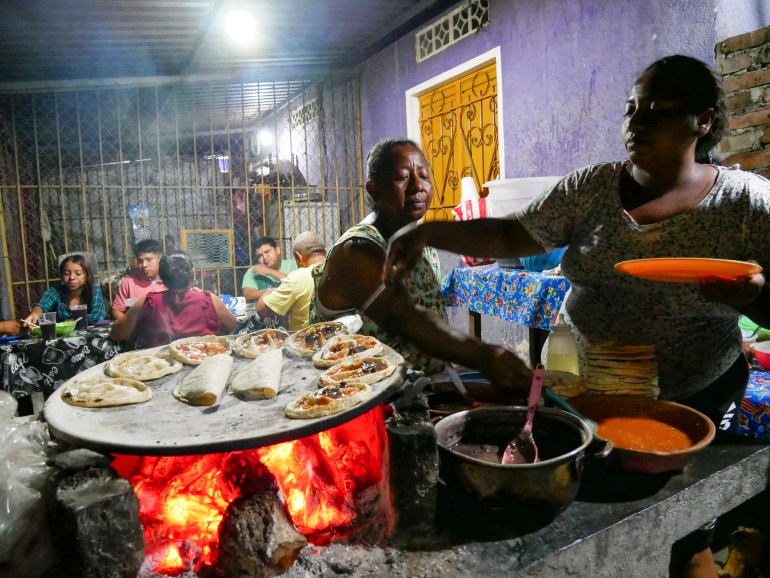ARTICLE AD
Oaxaca, Mexico – Outside Mama Cointa’s home where she has lived for almost all her life, guests have gathered to celebrate her 101st birthday. Her friend Victor steadies her quivering hand with his own while she tilts a ribbon-wrapped bouquet of wilting flowers to her nose. Her son Don Amado ushers visitors inside their family home.
“Our home is the last of its kind here,” Amado said, ducking underneath a sheet of thatched palm leaves hanging over the entranceway to a windowless, one-room house, where he was raised by his mother, Mama “Cointa” Chavez Velazco, in the village of Tecoyame, Oaxaca.
“But it may not be around next year. There is no support to help us, no money to maintain it as the climate becomes more extreme and threatens us more,” Amado added, before stealing a glance at his mother, whose milky blue eyes have begun to flood with tears.
“We are forgotten.”
Known as “El Redondo”, Mama Cointa’s house is an icon of the Costa Chica, the “short coast”, which spans approximately 400km (250 miles) across two states that straddle the Pacific Ocean. More Afro-Mexicans live here than anywhere else in this country of nearly 130 million people. Longer and harsher dry seasons in recent years have produced intense droughts in Tecoyame and nearby towns, hardening and cracking the land and leaving the parched soil unable to absorb the water from Mexico’s rainy season. Instead, the rainwater careens off the concrete-like surface, splashing up against the village’s homes and weakening their foundations.
 Homes in Mexico’s 400-year-old Black community are threatened by climate change [Mirja Vogel/Al Jazeera]
Homes in Mexico’s 400-year-old Black community are threatened by climate change [Mirja Vogel/Al Jazeera]
With circular walls built from mud and sand – and a cone-shaped roof bound together with vines, palm leaves and wooden beams – this type of home was first built in Mexico by African slaves brought to Mexico by the Spanish conquistadors in the 16th century.
A fraction of them escaped the shackles of slave owners, fleeing quickly through the wild and hidden hills that characterise Mexico’s vast Pacific coastline. Settlements like Tecoyame, which is just a couple of kilometres from the beaches where slave ships landed, were constructed with only the materials that were available at the time, and homes like Mama Cointa’s have sheltered generations of African-descended Mexicans for hundreds of years.
“El Redondo in Tecoyame is a symbol of the important African heritage here, just like food, dance, and music also are,” Victor Guzman, a local historian and hospitality manager, told Al Jazeera. “They are tangible examples of the history, suffering, development and identity of Afro-Mexicans.”
Discovering Mexico’s ‘black pearl’
Guzman lives 30km (19 miles) north of Tecoyame in Cuajinicuilapa, one of the largest cities on the Costa Chica. It is home to 27,000 people, of which 75 percent identify as Afro-Mexican. Cuajinicuilapa is a city like no other in Mexico. Erased years ago from tourist travel guides and largely unknown to much of Mexico, the city is self-made, self-contained, and defiantly proud.
Locals refer to it as Mexico’s “black pearl”, and like the precious gemstone, Cuajinicuilapa’s raw beauty is natural and unpolished, formed by the people who live there. It has also remained enclosed and isolated for much of its history, but not by choice.
With food spicier and flavours punchier than traditional southern Mexican dishes, Cuajinicuilapa has a strong culinary identity, rooted in African staple foods, and combined with Indigenous cooking methods and ingredients native to the Mexican states of Oaxaca and Guerrero.
 Women in Mexico’s oldest Black community prepare the region’s unique cuisine [Mirja Vogel/Al Jazeera]
Women in Mexico’s oldest Black community prepare the region’s unique cuisine [Mirja Vogel/Al Jazeera]
Fried bananas served with condensed milk are often consumed with spicy, crimson-coloured fish stews, slow-cooked pig cheek on fried corn pancakes or “sopes” and tamales de tichindas, mangrove mussels mixed with corn dough and wrapped in banana leaves.
With its proximity to the ocean, fish is a centrepiece of the community’s diet. It’s bought locally at sunrise each morning at a seaside market that resembles an auction, and sits at the edge of a stretch of untouched beach that is a short drive from Cuajinicuilapa. Black fishermen catch hundreds of kilogrammes of shimmering, colourful Pacific fish in the wee hours of the morning, and transport their haul to Cuajinicuilapa’s central market, where it is weighed.
What isn’t purchased there is given as payment to younger fishermen learning the trade, and the remainder is sold to fresh seafood restaurants in popular tourist spots like Acapulco and Puerto Escondido, often at a fivefold markup.
Beyond the food, the world-famous “devil dancers” credit Cuajinicuilapa as the home of their ceremonial dance. Like the local delicacies, the origins of the “Danza de los Diablos” are rooted in slavery, when the dance was performed as a form of prayer to the African god Ruja to beg for freedom from Spanish conquistadors.
Today, the dance has evolved into a vehicle to increase visibility and recognition for Afro-Mexicans. In recent years, devil dancers from Cuajinicuilapa have performed for Mexico’s President Andres Manuel Lopez Obrador, and within international cultural events in New York City’s Times Square and also in European capital cities.
One hundred years of solitude
Still, the region’s isolation, both geographically and politically, has left Afro-Mexicans with few resources to sustain their culture. As one example, Cuajinicuilapa’s Afro-Mexican history museum – one of the first of its kind in Mexico – hasn’t paid its staff a salary for 15 years and is now facing closure.
At his home, Abad Campos Rodriguez, one of the city’s leading dance and music teachers, also explained: “I have performed and taught the Danza de los Diablos to hundreds of children, but I can only continue for a couple more years as I’m getting old.”
He added: “There are not many teachers left here. I worry it won’t continue to the next generation.”
The same can be said for Mama Cointa’s home. With each rainless day, the soil grows harder and the cracks deeper on the farm where her son, Don Amado, works with his sons. The vegetable and fruit harvest that provides for four generations of the family is in peril as climatic conditions worsen, and the need for financial support grows.
 Children play in Mexico’s Costa Chica–the small coast–the Black community settled by fugitive slaves [Mirja Vogel/Al Jazeera]
Children play in Mexico’s Costa Chica–the small coast–the Black community settled by fugitive slaves [Mirja Vogel/Al Jazeera]
Like Mama Cointa’s home south of the city, institutions on the Costa Chica that offered Afro-Mexicans protection from the Spanish slave traders are also on the brink of collapse.
The core of the problem is the community’s social and economic marginalization. It was only in 2015 that the government census afforded Blacks here the opportunity to self-identify as Afro-Mexican, or people of African descent in Mexico. Four years later, campaigners secured a constitutional amendment to add Afro-Mexicans to the national list of 69 distinct cultural identities. Advocates hope that recognition within the country’s legal framework will bolster funding for healthcare, education and cultural projects for Afro-Mexicans, who account for approximately two percent of Mexico’s population.
But the results so far have been underwhelming. Angelica Sorrosa, the manager of the Afro-Mexican museum, told Al Jazeera that “Nothing has changed. We still feel like we are at the bottom.”
Sorrosa hopes that the presidential elections in June will provide her community with some relief. The frontrunner is Mexico City’s Governor Claudia Sheinbaum, a protegee of outgoing President Andres Manuel Lopez Obrador, who founded the leftist Morena party that is credited with lifting nearly five million people out of poverty since 2018.
“I want to believe that Claudia [Sheinbaum] will bring more change,” Sorrosa said. “She talks a lot about prioritising culture, but right now, I can’t be sure.”
Compounding that uncertainty is the tendency in Mexico, as elsewhere, to marginalize or “ghettoize” Black culture and uncouple it from Mexico’s broader cultural traditions.
Mijane Jimenez Salinas, president of Mano Amiga de la Costa Chica, a human rights non-profit organisation founded to support Afro-Mexican rights, said:
“We campaign for equality of opportunity. My daughter dreams of learning ballet, not just devil dancing, and she wants to learn languages and travel.”
Taking her daughter in her arms, she told Al Jazeera: “For that, she needs equal opportunities. I always grew up with limits, but I want her to feel she can do anything.”

 8 months ago
39
8 months ago
39 